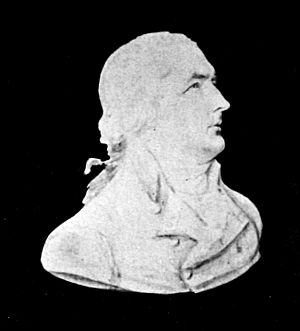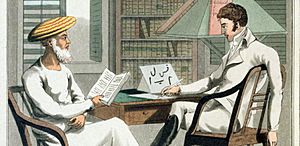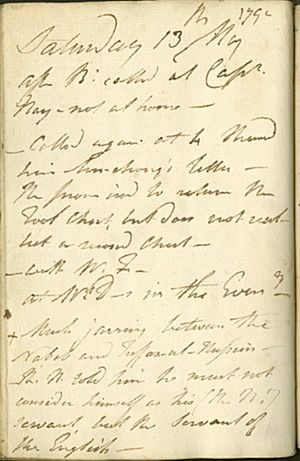James Dinwiddie (astronomer) facts for kids
James Dinwiddie (born December 8, 1746, in Dumfries – died March 19, 1815, in Pentonville) was a Scottish scientist. He was a physicist, astronomer, and inventor. He loved to share science with others. He traveled around England and Ireland, showing fun experiments. He also went to India and China. In China, he joined Lord Macartney on a special trip called the Macartney Embassy. His job was to teach about physics and show off British astronomy tools.
Contents
Early Life and Discoveries
James Dinwiddie was born on December 8, 1746. This was in Tinwald, near Dumfries, Scotland. His parents, John Dinwoody and Catharine Riddick, were farmers. James was one of five children. His father passed away shortly after James was born.
He worked on the family farm. Even as a young boy, he loved building things. He even made a wooden clock! He went to Dumfries Academy to study math and languages. Later, he continued his studies at the University of Edinburgh. His family hoped he would become a church minister. But James was much more interested in science.
After finishing school, he taught math and natural philosophy. Natural philosophy was what we now call physics. He became very interested in surveying and navigation. Surveying is about measuring land. Navigation is about finding your way, like on a ship. In 1778, he earned a Master of Arts degree. He was then invited to teach at Ayr.
Sharing Science with Everyone
James Dinwiddie loved to show how science worked. In his lectures, he did many experiments. He used scientific tools to explain ideas. He always showed how math was important in understanding physics. He believed that math helped you truly understand science.
He once said that without enough math, you would only know science like a schoolboy. He meant you wouldn't understand the deep reasons behind things. He wanted people to really grasp how science worked.
Dinwiddie did not earn much money at first. For a while, he taught geography. He was also interested in new inventions. When Charles Spalding, who invented a diving bell, died in an accident, Dinwiddie tried to figure out what happened.
He also got interested in hot air balloons. This was when people like Jean-Pierre Blanchard made ballooning popular. Dinwiddie found a way to make silk airtight for balloons. He even flew a balloon from Bristol to Waterford! He once almost lost all his equipment because he forgot to pay his rent.
Travels to China and India
In 1792, James Dinwiddie received an honorary Doctor of Law degree. This was from the University of Edinburgh. He was then asked to join Lord Macartney's trip to China. This trip was from 1792 to 1793. His job was to show science to the Chinese emperor. He brought a diving bell and a balloon. He also brought many astronomy tools.
He was first called "Machinist to the Embassy." Later, he was called "Astronomer." The Chinese were not very impressed by the British astronomy tools. But they liked a German-made planetarium called the Weltmaschine. This device showed how planets move.
After leaving China, Dinwiddie went to Calcutta, India. He met Sir John Shore, who was the Governor-General of Bengal. Dinwiddie decided to stay in Calcutta. He continued his scientific work there. In 1795, he gave lectures to many people in Calcutta. He taught about 180 ladies and gentlemen. He even earned money from these lectures.
Some of the tools Dinwiddie took to China were later sold in Calcutta. These tools were used by William Lambton. He used them for his early land surveys in southern India.
In 1795, Dinwiddie got a job helping the Board of Trade with science. He earned a good salary for a year. He also built a special battery called a voltaic pile. He claimed he used electric shocks from this battery to help people with health problems.
Teaching and Research in India
In 1801, Dinwiddie became a professor. He taught natural philosophy at Fort William College. He gave lectures and demonstrations to Europeans and wealthy Indian people. He also trained Indian students in astronomy. Two of his students were Hurry Mohun Thakoor and Gopee Mohun Deb. Another student was the surveyor James Rennell.
Dinwiddie also advised the East India Company. He prepared a chemistry kit for Francis Buchanan. This kit was used for a survey in Mysore. He also made nitrous acid for a hospital in Calcutta. He wrote letters to Joseph Hume in London. Hume was his agent and sent him chemicals. In 1796, Dinwiddie visited Madras. He met the Governor, Lord Hobart, there. He also became a member of the Asiatic Society of Bengal.
Dinwiddie strongly believed that math was key to understanding science deeply. He said that science could only be truly successful when it used math. He felt that without math, your understanding of science would be very basic.
A scholar named Allama Tafazzul Husain Kashmiri had already translated Isaac Newton's famous book "Principia" into Arabic in 1789. After Dinwiddie started teaching in Calcutta, Allama Tafazzul Husain Kashmiri became his student in 1794. Dinwiddie first taught him about optics (the study of light). Then he taught him modern geometry.
Dinwiddie was surprised that Tafazzul struggled with math. He wrote in his notes that it was strange for someone who read so much theory to be so bad at practical math.
Allama Tafazzul Husain Kashmiri was also an ambassador. This job took up a lot of his time. So, he had to stop his lessons with Dinwiddie for a while. Back in Lucknow, his ruler was unhappy. The ruler called him a "servant of the English." This was because Tafazzul was spending too much time learning modern science. In November 1795, he started lessons again. This time, Dinwiddie taught him experimental astronomy.
Later Years
James Dinwiddie left India in September 1806. He returned to England. He settled in London. There, he put together a collection of interesting items. These were things he had collected from India, China, and Java.
As he got older, his hearing and health became worse. But he still continued his scientific work. He even went to other scientists' lectures. In 1810, he was chosen to join the Royal Institution. He also became a member of a committee for math and inventions.
Dinwiddie never married. But he did have a daughter named Ann. She was named after her mother, Ann Muir.
See also
- Tafazzul Husain Kashmiri
- Reuben Burrow




